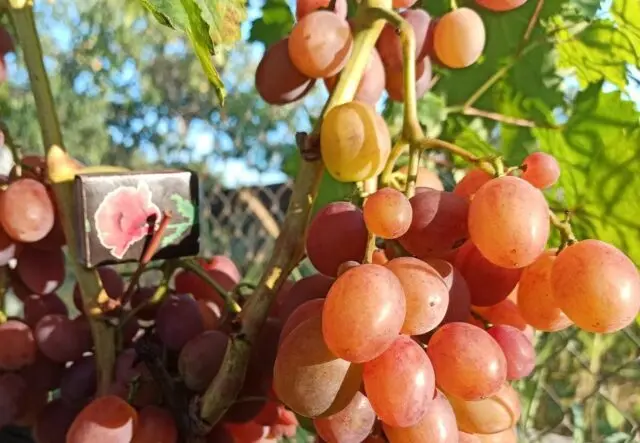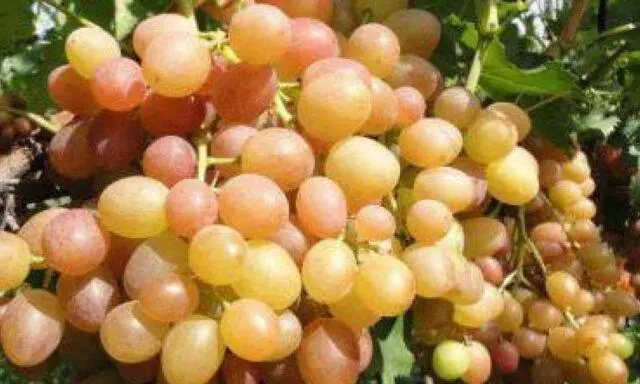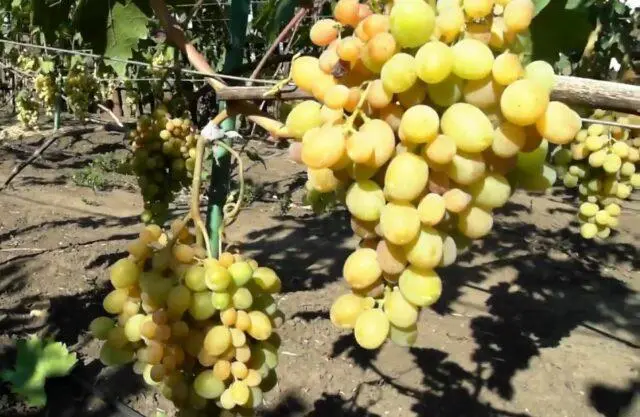Contents
Chameleon grapes are a hybrid bred by a Ukrainian breeder based on the pollen of three varieties. Differs in very high productivity, large berries with the expressed sweet taste. Mostly I use them fresh. Berries can also be used to prepare blanks for the winter.
History of occurrence
The Chameleon grape variety was bred by the Ukrainian breeder N.P. Vishnevetsky. The author is an amateur, and he has been working on the creation of varieties for many years. In recent years, Vishnevetsky has focused on breeding new varieties that met several requirements at once – an attractive presentation, large berries, good keeping quality and transportability.
Within a few years, the breeder received 15 different hybrids, which in many respects met all the criteria described. One of these hybrids was the Chameleon grape. It was obtained as a result of complex hybridization based on four known varieties:
- Arcadia;
- Light raisins;
- Atlant Zaporozhye;
- Glasha.
The cultivar Atlant Zaporizhsky, which has a female type of flowering, served as the mother form. From the pollen of the other three varieties, Vishnevetsky obtained a mixture, which he used for fertilization. Subsequently, an artificial selection of seedlings was carried out, thanks to which it was possible to choose the most suitable option, which had a number of advantages:
- excellent presentation;
- large-fruited;
- good taste;
- great strength of growth;
- increased productivity;
- winter hardiness;
- immunity to fungal diseases.
It was this variety of grapes that was called the Chameleon. The hybrid has not yet been included in the register of breeding achievements. However, it managed to spread in different regions of the country. The variety is valued for its good taste, large-fruitedness and relatively high winter hardiness.
Description of the grape variety Chameleon
The leaves of the Chameleon grapes are rounded, large, somewhat stretched in width. The plate is five-blade, the degree of dissection is small. The surface is glossy, saturated green, reticulate-wrinkled. The veins are lighter, also green in color, and at the base they are reddish. Triangular teeth are noticeable along the perimeter of the plate, their edges are even, and the tops are sharp.

Large, pink-orange fruits
Side cuts in the upper part of the Chameleon grape leaf of small depth, open type, in the form of an incoming corner. At the bottom, the cutouts are small, the shape is V-shaped. Petiolate notches are vaulted, the bottom is pointed or flat. Petioles of Chameleon grapes are quite long, the color is red. The flowers are bisexual, so the plant is self-pollinating.
bunches
Clusters of Chameleon grapes are often loose, torn. There may be many small berries, due to which the presentation deteriorates. This is usually due to abundant flowering. It is better to remove a few inflorescences – then the clusters will be beautiful, regular cone-shaped.
Berries
The berries of the Chameleon grape are very large, reaching a mass of 10-14 g. The color is pink-orange, it appears for a rather long time. Some berries remain green, which does not impair their taste. The peel is dense, crunches when biting.
Vine
Chameleon grapes are varieties with great growth vigor. It gives a powerful bush, reaching a height of 1,5-2 meters. At the same time, the shoots grow quickly, reaching a length of 5 m. The crown is sprawling and takes up a lot of space.
Characterization
Hybrid Chameleon is characterized by early ripening and high yield. The shrub tolerates winters and droughts well, is characterized by normal immunity to most fungal diseases.
Maturation period
The berries ripen within 110 days from the moment the buds swell. According to this indicator, the Chameleon hybrid belongs to the superearly ones. The first bunches are harvested in early August. Although they form green, they are best left on the branch until they are fully ripe in September or early October.
Productivity
Chameleon grapes are characterized by very high yields. From one adult bush you can collect up to 30 kg. Moreover, sometimes such large specimens grow that 40-50 kg are collected from them.

Productivity reaches 30-50 kg from one bush
Chameleon grape flavor
The pulp of Chameleon grapes is fleshy, juicy, sweet taste (sugar content reaches 18%), very pleasant, with a delicate sourness. As a rule, there is no nutmeg aftertaste. Most gardeners rate palatability at least 4,5 out of 5.
Growing regions
The Chameleon grape is a winter-hardy crop. Therefore, it can be grown not only in the south, but also in other regions of the country:
- the Volga region;
- Chernozem region;
- the middle lane, including the Moscow region.
If desired, seedlings can be planted even in Siberia and the Urals. But in this case, care will be especially difficult due to harsh winters and temperature changes.
Frost resistance
Chameleon grapes are highly winter hardy. Even without shelter, the shrub can withstand up to -22 degrees. However, in most regions of Our Country (except the south), the temperature in winter drops even lower. Therefore, the roots are carefully mulched, and the bushes themselves are protected with dense material.
Drought tolerance
The Chameleon grape hybrid is resistant not only to frost, but also to drought. It tolerates heat and other adverse weather conditions. To get a good harvest, infrequent but regular watering should be organized.
Disease and pest resistance
Chameleon grapes have a fairly good resistance to various diseases. Immunity in culture is formed gradually. Therefore, in the first 3-4 years after planting, treatment with fungicides and other drugs is carried out on a regular basis.
Application
Chameleon grapes are table varieties. It has a sweet dessert flavor. Berries are used fresh, as well as for making juice and other preparations. The shelf life is very long. If the conditions are met, the bunches can lie up to six months. The fruits are transportable, so they can be transported to the place of sale or processing, including over long distances.
Advantages and disadvantages
Chameleon grapes have a number of advantages. First of all, gardeners appreciate it for its interesting taste, large marketable berries and high yields. Culture has other benefits as well. The berries are large and very tasty.
Pros:
- very good taste;
- large-fruited;
- high yield;
- early ripening;
- resistance to fungal diseases;
- drought tolerance;
- high winter hardiness;
- keeping quality;
- transportability;
- undemanding to the composition of the soil.
Cons:
- sometimes the clusters become smaller, become loose;
- shrub spreading, takes up a lot of space.
Planting Chameleon grapes in the open field
Most often, the planting date is planned for the end of September, about four weeks before the frost. The place is chosen open and not lowland, without stagnant water. A distance of 2,5 meters is left between seedlings, as they grow rapidly and occupy a large area.

Between seedlings leave a distance of 2,5 meters
The parameters of the landing pit are standard – 70 * 70 cm. When planting, the seedling is covered with fertile soil, watered with settled water and carefully mulched for the winter. The trunk circle is sprinkled with sawdust, straw, hay or other material.
Caring for Chameleon grapes
Caring for Chameleon grapes is simple. Watering is not done so often, fertilizers are applied 2-3 times per season. The soil is periodically loosened and weeded.
Features of caring for this variety:
- There are a lot of clusters, so the branches are tied to the trellis in the first year.
- To prevent the berries from shrinking, some of the ovaries must be removed.
Conclusion
Chameleon grapes are one of the most interesting large-fruited grape varieties with pink berries. The hybrid adapts well to different climatic conditions, which makes it possible to grow it even in the middle lane. Care is not very difficult, so even novice gardeners can cope with cultivation.









